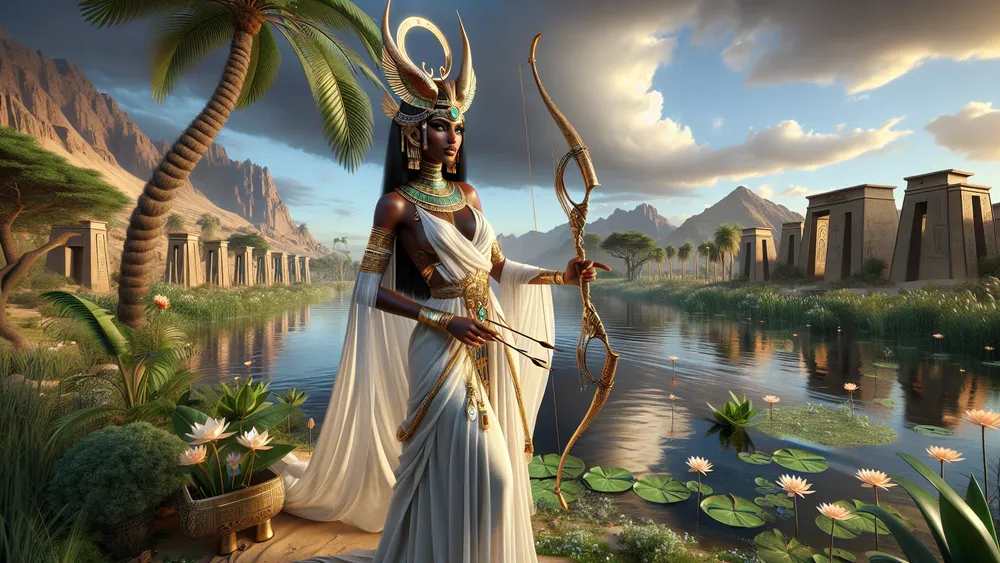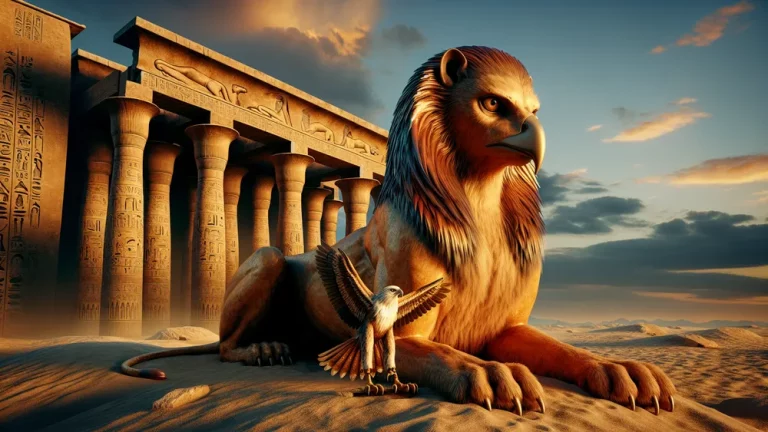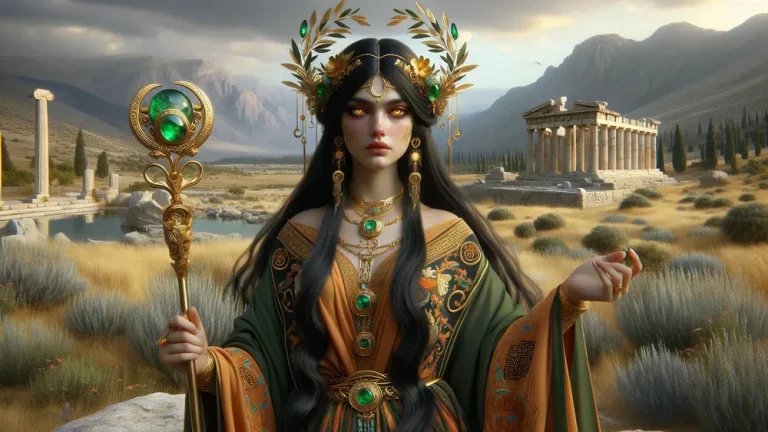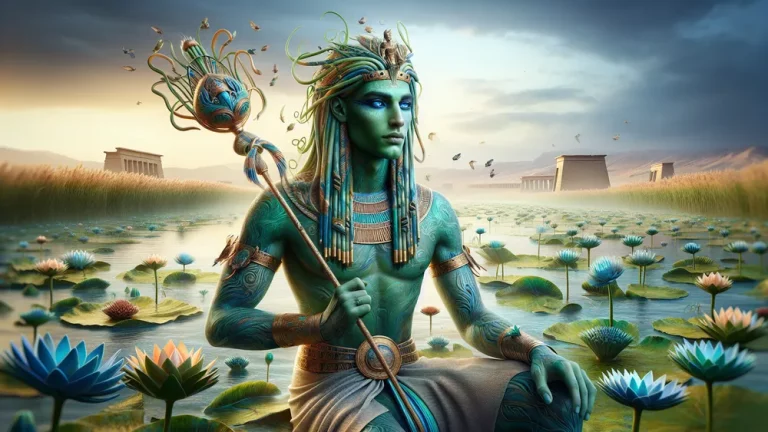Satet: Egyptian Goddess Of Water And Archery
Welcome to our look of Satet, the Egyptian goddess of water and archery. In a time when the yearly flooding of the Nile River was the most looked-forward-to happening of the year, bringing life and fertility to the land, Satet was revered as a divine force behind this life-giving flooding. In this blog post, we will explore her beginnings, her place among the group of Egyptian gods, and her unique signs and qualities.
Key Points:
- Satet is the Egyptian goddess of water, growth, and archery.
- She is linked to the Nile River and its yearly flooding, crucial for farming.
- Satet is often represented with a bow and arrow, ankh, and the crown of Upper Egypt.
- She is closely connected with Khnum, the god of the Nile’s source, and their daughter Anuket.
- Satet’s worship included ceremonies, offerings of water and growth items, and special feasts.
- Temples dedicated to Satet were central for prayer and group activities in ancient Egypt.
- Satet’s influence impacted daily life, farming, art, and stories in ancient Egyptian society.
You will learn about her links with other gods, her role as a defender and female hunter, and how she was respected by the older Egyptians. Whether you are new to Egyptian stories or looking to deepen your knowledge, this thorough explainer will provide you with a detailed look at Satet’s importance in older Egyptian life.
Satet: Overview and Key Facts
| Key Point | Details |
|---|---|
| Name | Satet (also spelled Satis or Satit) |
| Role | Goddess of water, growth, and archery |
| Representations | Bow and arrow, ankh, and the crown of Upper Egypt |
| Primary Association | The Nile River and its yearly flooding |
| Major Temples | Elephantine Island and Sehel Island |
| Partner | Khnum, the ram-headed god of the Nile’s source |
| Child | Anuket, goddess of the Nile and its waterfalls |
| Pictures | Often shown wearing the crown of Upper Egypt, holding a bow and arrow |
| Key Texts | Pyramid Texts, Coffin Texts, and various temple writings |
| Ceremonies and Gifts | Ceremonies to make sure the Nile’s flooding, gifts of water and growth items |
| Historical Period | Worship dates back to the early period and continued through the later time |
| Importance | Important to farming and everyday life in ancient Egypt |
How Satet Got Started
To understand Satet’s importance in old Egyptian stories, it’s important to look into her beginnings and early connections. Now, let’s look into her past and her start in myths.
Her Background and Mythical Beginnings
Satet’s beginnings in old Egyptian stories go back to early times, where she was respected as a goddess of the Nile River and its life-giving floods. Imagine living in a place where the yearly flooding of the Nile was not just a natural thing but a holy help that made sure your people survived.
Satet was believed to be the divine force behind this important flooding, bringing growth to the land and good fortune to the people. Her respect was especially noticeable in the area of Elephantine Island, where she was seen as a defender of the southern border of Egypt and a protector of the Nile’s waters.
Her connection with the Nile River and its flooding is clearly written in various old writings. These sources give helpful information about her role and importance in Egyptian stories. Some of the main writings talking about Satet include:
- Pyramid Texts: These are some of the oldest religious writings from old Egypt, inscribed on the walls of pyramids and talking about Satet in the context of the afterlife and the Nile’s flooding.
- Coffin Texts: These writings, found in coffins from the Middle Kingdom, also reference Satet and her role in making sure of the land’s growth.
- Temple Inscriptions: Various temples, especially those on Elephantine Island, have inscriptions and pictures of Satet, showing her importance in local respect and ceremonies.
By examining these sources, we gain a deeper understanding of how Satet was seen and honored by the old Egyptians, showing her important role in their stories and everyday life.
Satet’s significance in ancient Egyptian culture was rooted in her role as a goddess of the Nile River and its life-giving floods, crucial for the survival and prosperity of the people, as evidenced in various ancient writings like the Pyramid Texts, Coffin Texts, and Temple Inscriptions.
Satet’s Spot in the Egyptian Gods’ Lineup
In the large and complex group of Egyptian gods, Satet holds a special and important place. She is mainly known as a goddess of water and growth, but her job goes beyond these areas. Satet is often shown as a protector of the southern border of Egypt, especially around the area of Elephantine Island.
This important spot highlights her job in protecting the land and making sure the important waters of the Nile went to the fields. Her job was crucial in keeping the land balanced and prosperous. Satet’s connections with other gods further show her importance. She is closely linked with Khnum, the ram-headed god who controlled the source of the Nile.
As his partner, Satet worked with Khnum to ensure the yearly floods of the Nile, important for farming. Their daughter, Anuket, also had a very important job as the goddess of the Nile and its waterfalls.
Satet, Khnum, and Anuket formed a group of three that was central to the ways of worship in the area of Elephantine, highlighting their linked jobs in supporting life and growth in old Egypt.
What Satet is Known For
Now that we have looked into Satet’s beginnings and her place among the Egyptian gods, we will look into the special traits and signs that describe her.
Her Looks and Symbols
Satet is often shown in old Egyptian pictures with clear signs and images that highlight her god-like traits. She is usually shown having the White Crown of Upper Egypt, decorated with antelope horns, which show her link to the area and her protective role.
This crown is like a modern-day emblem of authority and guardianship, but we should imagine it simply. Satet is also often shown holding a bow and arrows, showing her job as a huntress and protector. Moreover, she is sometimes shown carrying an ankh, the sign of life, which further shows her link with fertility and the life-giving waters of the Nile.
Many items and drawings of Satet were found, giving valuable insights into how she was honored in old Egypt. Here are some noteworthy examples:
- Statue of Satet from Elephantine: A well-preserved statue found on Elephantine Island, shows her traditional crown and bow.
- Carvings in the Temple of Satet: Various carvings in her temple on Elephantine Island show her with other gods, highlighting her importance in the local group of gods.
- Small Objects and Statues: Small objects and statues of Satet, often made of ceramic or rock, were often used by old Egyptians for protection and blessings.
- Drawings on Papers: Drawings on papers, like those found in the Book of the Dead, often include pictures of Satet in scenes related to the afterlife and the Nile’s flooding.
These pictures not only show Satet but also give a look into the religious practices and beliefs of the old Egyptians who worshipped her.
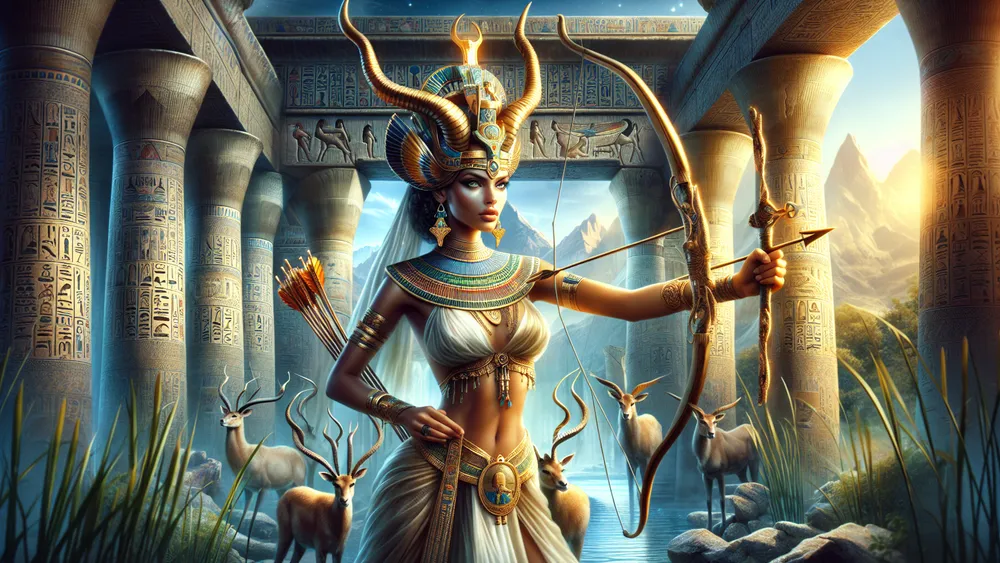
Satet and Her Bow and Arrow
The bow and arrow are central to Satet’s images. They show her skill as a hunter and her job as a protector.
Like today’s protector, but in a different time, Satet’s bow and arrows show her skill to protect the Nile and its people. These weapons highlight her watchfulness and readiness to ward off any dangers, making sure of the safety and growth of the land. As a hunter, Satet was believed to help her people by getting animals and keeping nature balanced.
Her showing with these strong signs highlights her two jobs in old Egyptian stories as both a strong protector and a helper, embodying the strength and food needed for the group’s survival.
Satet’s Link to Water and Growth
Satet’s link to the Nile River and its yearly flooding is a key part of who she is in old Egyptian stories. The Nile’s flooding was a vital happening that filled the soil with good dirt, making it good for growing things. Satet was believed to control this life-giving flood, making sure the waters rose and fell in a way that would help the land and its people.
Think of her as like today’s water system, looking after the distribution of water to make sure crops get the water they need. This link to the Nile made Satet a critical god for the food and wealth of old Egyptian society.
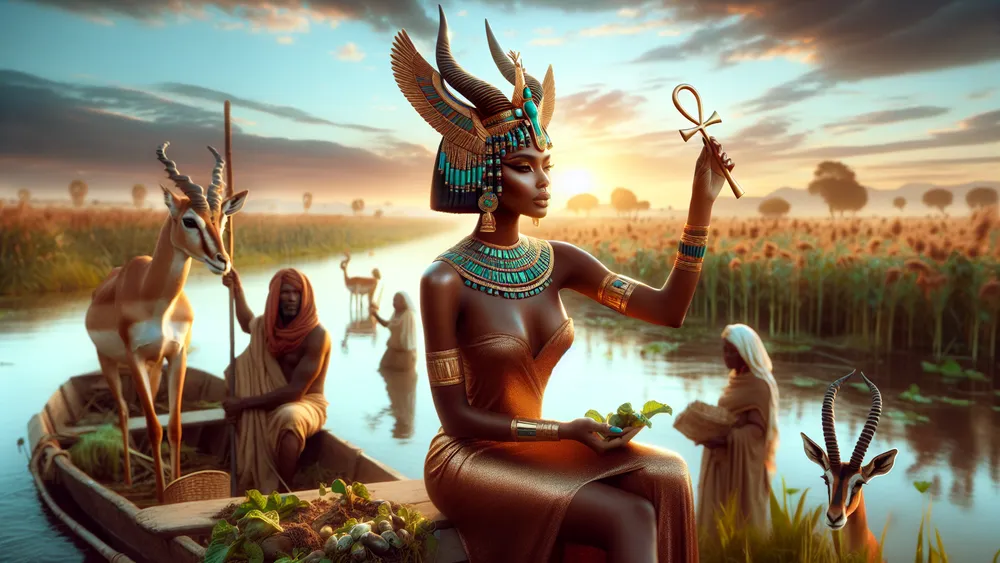
Moreover, Satet played a vital role in making sure there was enough water and food. She was often called to give the land enough water, which was needed for growing crops and keeping livestock. To gain her favor, the old Egyptians performed many acts and gave gifts specifically made to please her. Here are some of the common acts and gifts made to Satet for water and growth:
- Pouring out Water: Giving water to Satet as a symbol of her control over the Nile.
- Offering Animals: Giving animals, especially those linked with fertility, as offerings.
- Special Feasts: Holding group meals in her honor to celebrate and ask for her blessings.
- Statues and Amulets: Making and giving statues and amulets of Satet to be put in homes and temples.
- Prayers and Hymns: Saying specific prayers and hymns that praise her and ask for her help in making sure of a good crop.
These practices show the great respect the old Egyptians had for Satet and their dependence on her to keep things steady in their world.
Satet’s connection to the Nile River and its flooding was crucial in ancient Egyptian beliefs for agriculture and prosperity, with rituals and offerings made to seek her favor for a bountiful harvest.
How People Honored Satet
Having looked at Satet’s traits and her important job in making sure there was water and growth, let’s look at the ways the old Egyptians respected her through temples, acts, and special priests.
Temples and Holy Places
The main temples made for Satet were important places for prayer and group activities in old Egypt. The most well-known one is the Temple of Satet on Elephantine Island, which started in the Early Dynastic Period and kept getting bigger over the years.
This temple was well-placed near the first cataract of the Nile, a critical spot for keeping the river’s movement and making sure of the yearly flooding. Think of this temple as a place full of people like a group center now, where people came together not just for prayer events but also for group and money activities.
Another important place is the Temple of Satet at Sehel Island, which had an important job in area prayer matters.
To show this better, here is a table showing the locations, dates, and special points of these main temples made for Satet:
| Temple Location | Date Started | Special Points |
|---|---|---|
| Elephantine Island | Early Dynastic Period | Close to the first cataract, got bigger over time, big prayer events |
| Sehel Island | Middle Kingdom | Important area prayer place, writings and carvings showing Satet |
These temples were more than just places for prayer. They were main places for the group, where people asked for Satet’s blessings for water and growth. The big buildings and important locations of these temples highlight how important Satet was in the everyday life of the old Egyptians.
Rituals and Special Celebrations
The rituals and celebrations done for Satet were very important to the people in old Egypt, for religious and group reasons. One big ritual was the yearly “Feast of Satet,” which happened with the Nile’s flooding. During this celebration, gifts of water, food, and flowers were made to Satet to get her ongoing help for a good flood.
Think of this as like a festival today, where people join to be happy and say thank you for the good things from the land. These celebrations were ways to show respect but also helped with group unity, strengthening their dependence together on Satet’s help for their farming and money.
The importance of these celebrations was in their ability to bring people together with a shared goal, creating a feeling of group identity and thankfulness.
Satet’s Priests and Priestesses
The priests and priestesses working for Satet did important jobs in keeping the prayer activities and acts for her. Their jobs were to do daily offerings, lead events, keep the temple clean. The religious leaders of the temple like church leaders today oversee prayer times and group activities. To become a priest or priestess of Satet, people had hard learning, including learning holy writings, learning special acts, and joining start events.
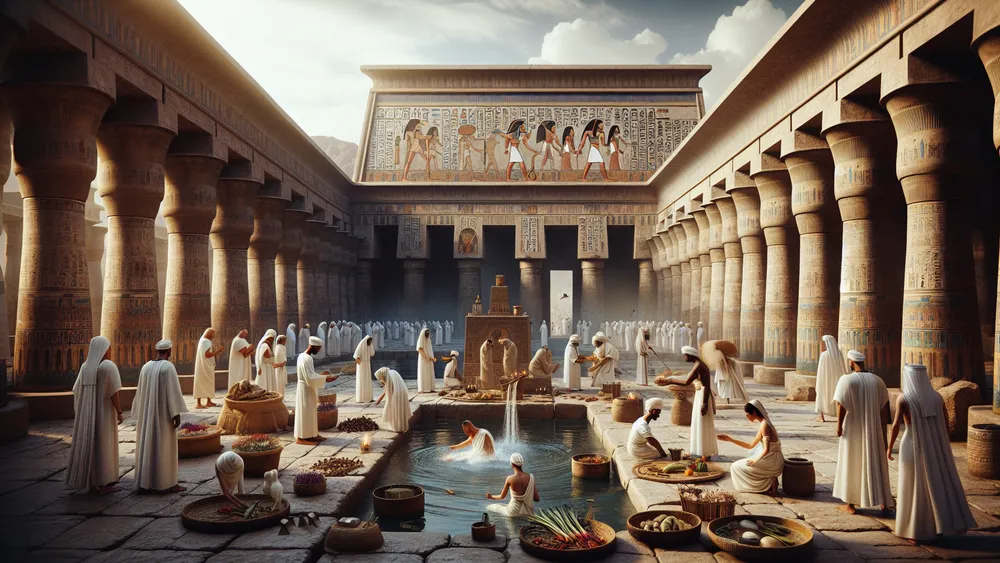
These cleaning acts often meant people would wash in the Nile to show they were ready to work for the goddess. This learning made sure they were ready to do their jobs, keeping the holiness and power of the worship of Satet.
Satet in Everyday Egyptian Life
After looking at the rituals and temples, and the jobs of her priests and priestesses, now we will see how Satet’s presence affected the everyday life and actions of the ancient Egyptians.
How She Influenced Daily Life and Farming
Honoring Satet had a big effect on the everyday life and farming of the ancient Egyptians. Satet was linked to the Nile’s flood, and she was thought to manage the yearly floods vital for farming. Farmers would offer prayers and sacrifices to Satet to make sure the floods were good and on time. As farmers now use weather reports.
Her power was more than just farming; local people often went to her temples to join group acts, which built unity and a common goal. These were not only prayer times, but also social times that made community ties strong and helped trade and talk.
So, Satet’s following played a key role in the prayer part and the everyday part of life, helping with wealth and unity of the groups that honored her.
Satet in Art and Stories
Satet is often shown in old Egyptian art, mostly shown with the White Hat of Upper Egypt and holding a bow and arrows, which shows she was a hunter and guard. In lots of temple pictures and statues, she is standing or seated. Sometimes she is next to other gods like Khnum and Anuket.
Her art pictures were not only for looks but were main points for honoring and respecting, like holy pictures in many places now. Her pictures in art made stronger her godly features and made her real to her people, always seen and there, with her guarding and caring traits.
Besides art you can see, Satet is also in many hymns, prayers, and stories that show her big role in Egyptian tales. Hymns for Satet often praise her for bringing the Nile’s life water, needed for land growth. One hymn says, “Hail Satet, who causes the flood to rise, who brings abundance to the fields and joy to the hearts of men.”
These writings were read out loud during religious times and big days. They showed devotion and kept her stories going through time. By looking at these texts, we learn how the old Egyptians saw Satet and the big part she had in their prayers and everyday life.
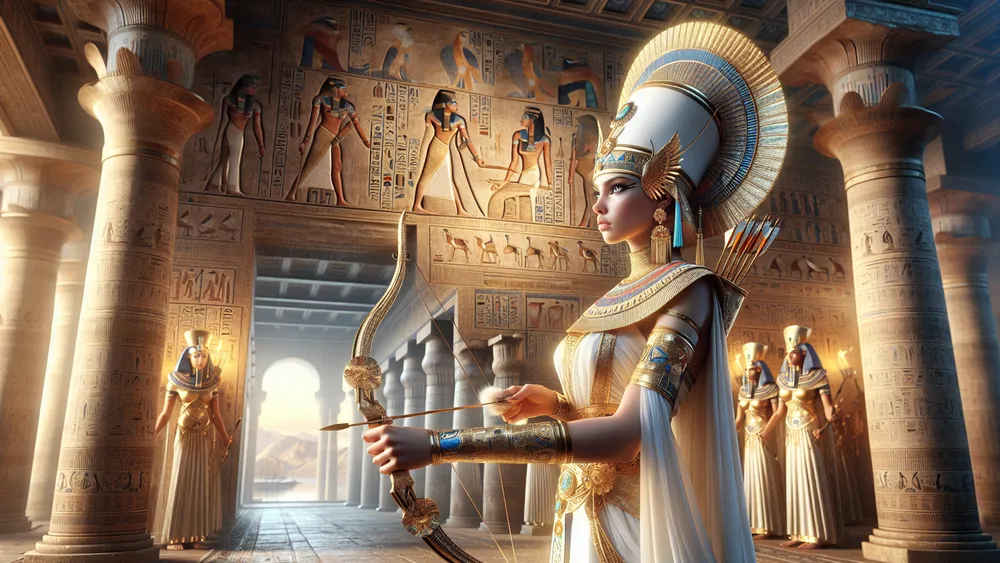
The Egyptian Gods’ Family Tree
Knowing the family tree of Egyptian gods is important for getting the detailed ranking of the gods since this family tree shows the linked jobs and tales of gods like Satet, Khnum, and Anuket. For a full look at all the big gods, look at this list of all the Egyptian gods.
This link gives info on each god, so you can see how each one is part of Egyptian mythology.
FAQs
1. Who were Satet’s parents in Egyptian mythology?
Satet’s parents in Egyptian mythology are often considered to be Ra, the sun god, and Hathor, the goddess of love and motherhood.
2. What animals are associated with Satet?
Animals associated with Satet include the antelope, which symbolizes her grace and agility.
3. How did Satet’s worship change over time?
Satet’s worship changed over time as her role evolved from a local deity of the Nile’s inundation to a more widely revered goddess associated with fertility and protection.
4. Are there any modern practices or festivals that honor Satet?
Modern practices or festivals that honor Satet are virtually nonexistent, as her worship has largely faded over time.

